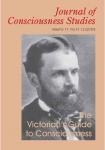
Reviewed by Tom Ruffles
This special issue of the Journal of Consciousness Studies was published to mark the centenary of William James’s death in 2010 and is dedicated to David Fontana (1934-2010), SPR president during 1995-8 and vigorous promoter of transpersonal psychology. This is especially appropriate as James was himself SPR president 1894-5. Guest edited by Allan Combs, the issue contains a wide variety of articles of mostly excellent quality which will act as a useful springboard for anyone with an interest in the development of psychology in the nineteenth century.
It examines the state of consciousness studies at that time, focusing largely on the work of James, and shows the continuing relevance of ideas developed during the period, such as those on the subconscious, altered states of consciousness, extra-sensory perception and survival of bodily death. While not specifically designed to air issues related to psychical research, the fact that the subject features so extensively indicates the importance of the SPR’s (and the American SPR’s) first two decades in the formation of psychology as a discipline. Collectively, the papers indicate the influence of psychical research on the development of psychology, a neglected past which is at last being rectified in recent scholarship examining the contributions and impact of such thinkers as James, Edmund Gurney and Frederic Myers. (Eugene Taylor is surely exaggerating though in referring to Myers as “long forgotten”. He has not exactly been missing from the SPR’s publications during the twentieth century, and the SPR ran a series of ‘Frederic W H Myers Memorial Lectures’ for many years from 1929. Mainstream psychology is not the world.)
After a foreword by the editor there is a commentary by Taylor which is helpful in highlighting some of the topics discussed (and his conclusion is that James at the time of his death was still fifty years ahead of where we are now!). Carlos Alvarado and Stanley Krippner examine dissociation through the work of James on mediumship, hypnosis and debates that were circulating around secondary personalities. G. William Barnard writes crisply about Henri Bergson’s theory of consciousness from Time and Free Will in 1889 to The Two Sources of Morality and Religion (1932). Although Bergson’s ideas had much in common with James’s, despite his celebrity during his lifetime he is much less well known (at least to Anglophone audiences and outside psychical research) than he should be, and it is to be hoped that Barnard will stimulate fresh interest in this underrated thinker. Jonathan Bricklin, in a complex and wide-ranging paper, deepens the discussion of James’s philosophy by examining his “neutral monism” (with which Taylor disagrees as a “colossal misreading” of James) and the ‘mystical’ question of whether consciousness is pre-existing and needs merely to be uncovered, as opposed to being generated.
Combs himself provides an overview of ‘Neurology and the Mind at the Turn of the [twentieth] Century’, showing how debates then were surprisingly similar to those of today, such as differences between views of mind which were pitched at a neurological level and those focusing on properties of consciousness, and how such differences affected treatment strategies. Combs, Krippner and Taylor combine to look at the mind as a “chaotic attractor”, and ask whether there is awareness outside attention. They examine thinkers such as James, Myers, Jean-Martin Charcot, and Pierre Janet, who all discussed dissociation, a phenomenon which indicated awareness outside attention, and who assisted in establishing where the boundaries of conscious awareness were. The situation was much more complex than historians of the intellectual life of the period have often assumed, and Sigmund Freud has in the past been given undue prominence in this fertile mix.
Arthur Hastings in a brief note ponders the type of radical transformation that happens like a switch being flipped, for example religious conversion. James addressed this phenomenon in The Varieties of Religious Experience, and an understanding of the process is still very relevant. Unfortunately the topic is not here given the dissection it deserves and does not address possible negative consequences of such radical transformations (for example in cults). An essay by Gary Schwartz examines alleged mediumistic communication with James, among others, and is out of place here. Eugene Taylor asks “Who Was Frederic William Henry Myers?”, an addition to the literature on a figure whose significance is being increasingly recognised. Taylor notes resonances between the study of consciousness in the nineteenth century and in the present, and acknowledges that the downgrading of Freudian views has opened up a space for a proper evaluation of other approaches, such as that of Myers (though one might add that it has been slow in coming over the last twenty or thirty years).
Other items of interest to psychical researchers are reviews of Michael Tye,‘s book Consciousness Revisited , Michael N. Marsh’s Out of Body and Near-Death Experiences and Charles Tart’s The End of Materialism. This issue of the Journal of Consciousness Studies will be of value to those interested in the intersection of psychical research and psychology when each was new(ish), and the lessons for discussions of consciousness today. Together the articles give a sense of what an amazingly productive period the end of the nineteenth century was for discussions of consciousness (rather like now in fact), and its enduring fascination.

